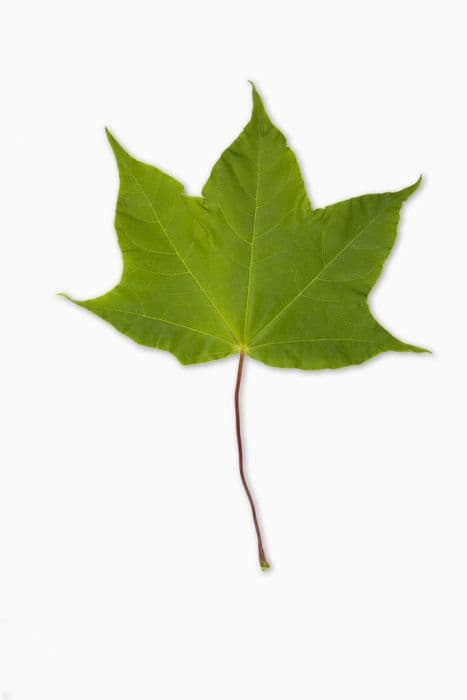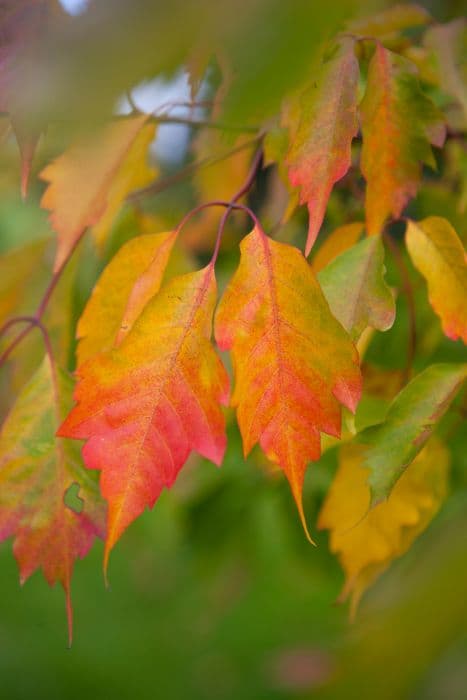Japanese Maple Acer palmatum 'Ariadne' (M/v)
ABOUT
The Japanese maple variety known as 'Ariadne' is renowned for its distinctive and attractive foliage. The leaves of this ornamental tree are finely dissected, giving them a lace-like appearance, and feature a unique color pattern that changes with the seasons. In spring, the foliage emerges with a blend of orange and red on the margins, while the centers of the leaves boast a lovely cream and pink hue. As the season progresses into summer, the leaves transform into a green color with pinkish overtones, still maintaining a variegated pattern with a contrasting mix of lighter and darker tones. The leaves are arranged in a palmate fashion, resembling an open hand with outstretched fingers, which contributes to the delicate texture of the canopy. In the fall, 'Ariadne' provides a splendid show as the leaves turn vibrant shades of yellow, orange, and red, creating a fiery display that stands out in the landscape. This Japanese maple cultivar also features a graceful branching structure that adds to its visual interest, especially during the winter months when the leaves have fallen, leaving the intricate, almost sculptural beauty of the branches exposed. The bark of 'Ariadne' is smooth and adds another layer of interest with its muted tones that complement the dramatic foliage. Overall, the 'Ariadne' Japanese maple is cherished for its dynamic and colorful foliage that provides a striking visual interest throughout the year, along with its elegant branch structure that offers winter appeal.
About this plant
 Names
NamesFamily
Sapindaceae
Synonyms
Japanese Maple, Ariadne Japanese Maple
Common names
Acer palmatum 'Ariadne'
 Toxicity
ToxicityTo humans
Japanese maple, generally, is not known for being toxic to humans. There are no well-documented cases of poisoning from ingestion of Acer palmatum 'Ariadne'. Therefore, ingesting parts of this plant is not expected to cause harm or result in any specific symptoms of poisoning.
To pets
Japanese maple, which is what Acer palmatum 'Ariadne' is commonly known as, is also not considered toxic to pets like cats and dogs. Ingesting this plant should not cause any significant symptoms of poisoning or serious consequences for your pets. However, it is always best practice to prevent pets from eating plants as individual animals might have unique sensitivities.
 Characteristics
CharacteristicsLife cycle
Perennials
Foliage type
Deciduous
Color of leaves
Variegated
Height
6-8 feet (1.8-2.4 meters)
Spread
6-8 feet (1.8-2.4 meters)
Plant type
Tree
Hardiness zones
5-8
Native area
Japan
Benefits
 General Benefits
General Benefits- Ornamental Appeal: Offers stunning foliage that changes colors from bright green and pink in the spring to shades of yellow and orange in the fall.
- Shade Production: Mature trees provide shade in gardens and outdoor spaces during hot summers.
- Habitat for Wildlife: Attracts birds and beneficial insects which help with pest control and pollination.
- Compact Growth: Suitable for smaller gardens or spaces where a larger tree wouldn't fit.
- Seasonal Interest: Adds year-round interest to the landscape with its changing leaf colors and attractive winter branch structure.
- Low Maintenance: Requires minimal care once established, aside from occasional pruning and watering.
- Cultural Significance: Associated with traditional Japanese garden aesthetics, bringing cultural significance and tranquility to gardens.
 Medical Properties
Medical PropertiesThis plant is not used for medical purposes.
 Air-purifying Qualities
Air-purifying QualitiesThis plant is not specifically known for air purifying qualities.
 Other Uses
Other Uses- Photography: The varied hues and delicate leaf patterns of Ariadne Japanese Maple make it an excellent subject for botanical photography and artistic compositions.
- Craft Material: Its leaves, especially during autumn when they change colors, can be used in crafts for making bookmarks, pressed leaf art, or in scrapbooking projects.
- Container Gardening: Due to its compact size, the Ariadne Japanese Maple suits container gardening, allowing for decorative placement on patios or decks.
- Horticultural Training: Gardeners can practice bonsai techniques on this plant, as its small leaves and growth habit lend themselves well to the art of miniature tree cultivation.
- Seasonal Decor: Branches and leaves from the Ariadne Japanese Maple can be incorporated into fall wreaths or other seasonal decor items.
- Culinary Presentation: While not edible, leaves can be used as a natural and artistic backdrop for plating and presenting culinary dishes in high-end dining establishments.
- Watercolor Painting: The tree's leaves can inspire artists, serving as models for watercolor paintings and drawings due to their intricate shapes and coloration.
- Tattoo Design: The unique leaf pattern and coloration of Ariadne Japanese Maple may inspire tattoo artists when creating nature-themed body art.
- Thematic Landscaping: This plant's dramatic seasonal color changes can be utilized in thematic gardens, such as fantasy or fairy-tale inspired landscapes.
- Educational Resource: It can be used in educational settings to teach students about deciduous trees, leaf morphology, and plant pigmentation changes throughout seasons.
Interesting Facts
 Feng Shui
Feng ShuiThe Japanese Maple is not typically associated with specific Feng Shui practices.
 Zodiac Sign Compitability
Zodiac Sign CompitabilityThe Japanese Maple is not used in astrology practice.
 Plant Symbolism
Plant Symbolism- Beauty: Acer palmatum, commonly known as the Japanese Maple, is often associated with beauty due to its delicate leaves and striking colors that change throughout the seasons.
- Change: The Japanese Maple symbolizes change as it displays a vivid metamorphosis of hues from bright greens in the spring and summer to fiery reds and oranges in the autumn.
- Peace: Its graceful form and the calming presence it brings to gardens often leads the Japanese Maple to be considered a symbol of peace and tranquility.
- Endurance: Despite its delicate appearance, the Japanese Maple is a hardy tree able to withstand the challenges of changing seasons symbolizing endurance and adaptability.
- Balance: With its balanced and harmonious growth pattern, the tree is also seen as representative of balance in life, reminding us of the importance of maintaining equilibrium.
- Grace: The tree's elegant structure is emblematic of grace, where every branch and leaf seems meticulously placed as if to showcase nature's artistry.
 Water
WaterJapanese Maple trees, such as the 'Ariadne' variety, prefer evenly moist soil, so water them when the top inch of soil feels dry, which typically equates to once a week during the growing season. In hotter periods, they may require watering twice a week. Use a soaker hose or drip irrigation to provide deep watering, ensuring the soil is moistened to a depth of at least 4 inches each time; this might translate to approximately 2 gallons per week, depending on soil type and weather conditions. Cut back on watering in the fall to prepare the tree for dormancy. Over the winter, water sparingly, only if there are extended dry spells.
 Light
LightJapanese Maples, such as 'Ariadne', thrive in locations that provide full to partial sunlight. The ideal spot would be one that offers morning sun and afternoon shade to protect it from the harshest rays, allowing for the striking foliage to maintain its vibrant colors without scorching. An eastern-facing location receiving at least 4 to 6 hours of direct sunlight is optimal for encouraging healthy growth and color development.
 Temperature
TemperatureThe 'Ariadne' Japanese Maple performs best in moderate climates and can tolerate a range of temperatures, ideally between 50°F to 80°F. Although the tree can handle temperatures down to about -20°F for brief periods, consistent temperature drops below 0°F can cause damage. Protecting the tree from extreme heat above 90°F is also important, especially recently transplanted young saplings, which may be more susceptible to temperature stress.
 Pruning
PruningPrune the 'Ariadne' Japanese Maple to maintain its shape and encourage healthy growth; this is best done in late winter or early spring before new growth starts. Remove dead or crossing branches and thin out the canopy to allow light to penetrate, which will promote interior growth. It's generally advised to prune no more than one-third of the tree at a time, and some years you may only need to do light pruning or even skip it altogether.
 Cleaning
CleaningAs needed
 Soil
SoilThe best soil mix for the Japanese Maple 'Ariadne' is one that is well-draining and consists of a combination of loamy soil, peat, and perlite or pine bark for aeration. The ideal pH should be slightly acidic, ranging from 5.5 to 6.5.
 Repotting
RepottingJapanese Maples like 'Ariadne' should generally be repotted every two to three years to refresh the soil and prevent root-bound conditions. Younger, faster-growing trees may require more frequent repotting.
 Humidity & Misting
Humidity & MistingJapanese Maple 'Ariadne' prefers average to high humidity levels but is adaptable to a wide range as long as it is not too dry.
 Suitable locations
Suitable locationsIndoor
Provide bright, indirect light and ensure good air circulation for 'Ariadne'.
Outdoor
Place in dappled shade, protect from harsh sun and wind for 'Ariadne'.
Hardiness zone
5-9 USDA
 Life cycle
Life cycleThe Japanese Maple 'Ariadne' begins its life cycle as a seed, which after stratification germinates in the spring. It then develops into a seedling, putting forth its first distinctive, variegated leaves that will change colors with the seasons. As it enters the vegetative stage, it grows slowly, maturing over several years into a small, ornamental tree with a beautifully structured canopy. During its reproductive stage, typically when it's mature enough, it produces small purple flowers which later yield winged samaras, or seed pods, that disperse for propagation. Throughout its life, the Japanese Maple 'Ariadne' goes through cycles of dormancy in the winter, where growth ceases temporarily and the leaves often drop, followed by a resurgence of growth in the spring. Its lifespan can extend over several decades with proper care and favorable conditions.
 Propogation
PropogationPropogation time
Late winter-early spring
The Japanese maple 'Ariadne' is best propagated through the method of softwood cuttings during the early to mid-summer when the new growth is still tender and flexible. Select a healthy branch and cut a piece about 4-6 inches (10-15 cm) long, ensuring that there are at least two sets of leaves. Remove the leaves from the bottom half of the cutting. Dip the cut end into rooting hormone powder to encourage root development. Plant the cutting in a well-draining soil mix, ensuring that the lower leaf nodes are buried. The cutting should be kept moist and in a warm environment with indirect light. In several weeks, the cutting should develop roots and can be transplanted to a more permanent location.









